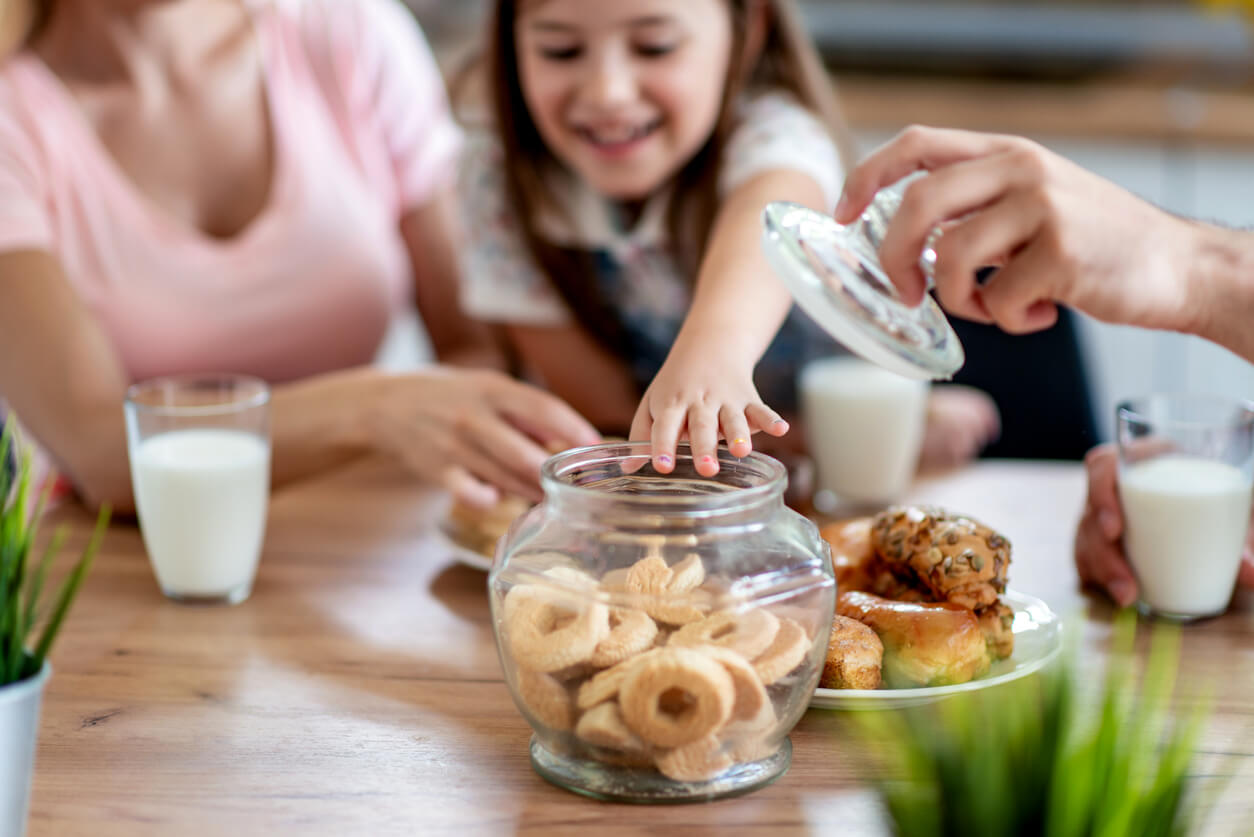Foods and Beverages that Damage Children's Teeth


Written and verified by the dentist Vanesa Evangelina Buffa
Paying attention to the oral health of children is one of the many responsibilities of parents. This goes far beyond focusing on oral hygiene. It’s also important to keep in mind that there are foods and beverages that damage children’s teeth and should be avoided. By knowing about the possible consequences, you’ll pay more attention when offering these snacks to your little one.
Know which foods and drinks damage children’s teeth
Sweets and soft drinks are often associated with dental problems. However, they’re not the only enemies of oral health. In fact, there are many foods that seem harmless but can damage children’s teeth. In this regard, diet plays a fundamental role in their health. Below, we’ll tell you which foods and drinks you should avoid or reduce.
Sweets
You probably already know that sweets and candies are among the most harmful foods for oral health. This is because the large amount of sugar they contain is used by bacteria in the mouth to grow and multiply. Therefore, when they metabolize it, they produce acids that lower the salivary pH, so they’re capable of demineralizing the teeth and giving rise to caries.
The consistency and texture of sweets are also factors that contribute to tooth damage. Namely:
- Soft and sticky candies remain stuck to the teeth and remain in the mouth for a long time. Therefore, the availability of the sweet substrate allows microorganisms to produce enormous amounts of acid.
- Hard candies and lollipops are also very harmful. By sucking on them for long periods of time, a very prolonged sugary and acidic environment is produced in the mouth. At the same time, when they’re chewed, traces of the candy can get trapped on the tooth surfaces. In addition, if they’re very hard, the enamel or the jaw joint can be damaged when biting them.
Although children enjoy eating sweets and candies, these are products that parents should try to avoid. Ingesting large amounts of sugar not only affects the mouth but also has an impact on overall health by causing problems such as obesity and diabetes. In any case, if you choose to give your child a treat, limit its consumption to special occasions and choose those that are less harmful, such as chocolates or sugar-free gum.

Soft drinks, juices, and sports drinks
Soft drinks, both traditional and diet versions, have an acidic composition that’s capable of removing minerals from the teeth. Fruit juices, on the other hand, far from being a healthy option, have a high sugar content, which allows bacteria to proliferate and produce harmful acids.
Many parents, when reading labels that say “100% fruit” or “natural ingredients”, believe that juices are less harmful than soft drinks. However, fruits also have sugar in their composition. In the case of citrus juices, they have an acidity of their own that also acts in a harmful way on tooth enamel.
In the same quest for some beverage that’s less damaging to health, some parents turn to sports or energy drinks. “If they’re used by athletes, they must be good” is often the belief. But this isn’t so, as they’re very acidic, and many of them have a high sugar content. Don’t forget that the ideal liquid to hydrate children is always water.
Citrus
Citrus juices are very acidic. This characteristic lowers the pH of the mouth and is capable of causing the loss of minerals from the dental structures. Therefore, the acidity of citrus fruits can have negative effects on the enamel. Oranges, tangerines, grapefruit, and lemon are some examples.
Eating citrus fruits provides vitamin C to the body, so eliminating them from your child’s diet isn’t the solution. What you should keep in mind is that after eating them, you should brush your teeth or rinse your mouth with water.
Pastries, breads, and cookies
Bread and other products rich in carbohydrates, such as pasta, flour, and starch, can be processed by bacteria and serve as a substrate for them to grow and multiply.
Pastries, cakes, and industrial cookies also have the addition of refined sugars. Therefore, when choosing these foods, it’s best to opt for whole-grain options. It is also better to opt for crunchy bread instead of sliced bread, as the latter has a gummier texture and adheres more to dental surfaces.

Sugar
Sugar is the main substrate that bacteria in the mouth use to grow. Therefore, consuming too much sugar poses a risk to teeth. Therefore, it’s best to reduce the consumption of industrialized products that contain sugar and pay careful attention to labeling.
In the case of home-cooked meals, it’s important to reduce the addition of sugar. Also, keep in mind that adding sweetener to milk, infusions, and other foods is a harmful habit for children’s mouths. And, of course, it’s important not to dip pacifiers and bottle nipples in honey or sugar to calm babies down.
Nuts and dried fruits
Nuts are foods that provide micronutrients and antioxidants that promote health. However, due to their consistency, attention should be paid to the way they’re offered to children:
- Hard nuts: Biting into these nuts can damage teeth. For example, walnuts or almonds can cause breaks in teeth or orthodontic appliances.
- Soft and sticky: Raisins, apricots, figs, or dried plums, among others, can leave residue in the oral cavity for a long time. Therefore, after eating them, it’s essential to rinse the mouth and brush the teeth.
Ice
Ice is a non-nutritious substance that we usually offer to children on hot days. However, when biting pieces of frozen water, tooth enamel is weakened and can fracture. With this, annoying symptoms such as tooth sensitivity will appear. So, if you use ice to cool the child’s drink, you must prevent them from biting into it.
Healthy alternatives to foods and drinks that damage children’s teeth
As you’ve seen, there are many foods and drinks that we offer that damage children’s teeth. Therefore, to prevent oral diseases, parents should look for healthy alternatives and include them in the menu. It’s also important to pay attention to the consistency of foods and avoid harmful habits such as snacking or adding sugar.
Eating a varied, balanced, and nutritious diet is essential for the growth and development of children. It also helps prevent cavities and gingivitis. In turn, reinforcing the care of the mouth with proper dental hygiene and frequent dental check-ups completes the necessary attention. With healthy dental habits, your child’s mouth will be protected.
Paying attention to the oral health of children is one of the many responsibilities of parents. This goes far beyond focusing on oral hygiene. It’s also important to keep in mind that there are foods and beverages that damage children’s teeth and should be avoided. By knowing about the possible consequences, you’ll pay more attention when offering these snacks to your little one.
Know which foods and drinks damage children’s teeth
Sweets and soft drinks are often associated with dental problems. However, they’re not the only enemies of oral health. In fact, there are many foods that seem harmless but can damage children’s teeth. In this regard, diet plays a fundamental role in their health. Below, we’ll tell you which foods and drinks you should avoid or reduce.
Sweets
You probably already know that sweets and candies are among the most harmful foods for oral health. This is because the large amount of sugar they contain is used by bacteria in the mouth to grow and multiply. Therefore, when they metabolize it, they produce acids that lower the salivary pH, so they’re capable of demineralizing the teeth and giving rise to caries.
The consistency and texture of sweets are also factors that contribute to tooth damage. Namely:
- Soft and sticky candies remain stuck to the teeth and remain in the mouth for a long time. Therefore, the availability of the sweet substrate allows microorganisms to produce enormous amounts of acid.
- Hard candies and lollipops are also very harmful. By sucking on them for long periods of time, a very prolonged sugary and acidic environment is produced in the mouth. At the same time, when they’re chewed, traces of the candy can get trapped on the tooth surfaces. In addition, if they’re very hard, the enamel or the jaw joint can be damaged when biting them.
Although children enjoy eating sweets and candies, these are products that parents should try to avoid. Ingesting large amounts of sugar not only affects the mouth but also has an impact on overall health by causing problems such as obesity and diabetes. In any case, if you choose to give your child a treat, limit its consumption to special occasions and choose those that are less harmful, such as chocolates or sugar-free gum.

Soft drinks, juices, and sports drinks
Soft drinks, both traditional and diet versions, have an acidic composition that’s capable of removing minerals from the teeth. Fruit juices, on the other hand, far from being a healthy option, have a high sugar content, which allows bacteria to proliferate and produce harmful acids.
Many parents, when reading labels that say “100% fruit” or “natural ingredients”, believe that juices are less harmful than soft drinks. However, fruits also have sugar in their composition. In the case of citrus juices, they have an acidity of their own that also acts in a harmful way on tooth enamel.
In the same quest for some beverage that’s less damaging to health, some parents turn to sports or energy drinks. “If they’re used by athletes, they must be good” is often the belief. But this isn’t so, as they’re very acidic, and many of them have a high sugar content. Don’t forget that the ideal liquid to hydrate children is always water.
Citrus
Citrus juices are very acidic. This characteristic lowers the pH of the mouth and is capable of causing the loss of minerals from the dental structures. Therefore, the acidity of citrus fruits can have negative effects on the enamel. Oranges, tangerines, grapefruit, and lemon are some examples.
Eating citrus fruits provides vitamin C to the body, so eliminating them from your child’s diet isn’t the solution. What you should keep in mind is that after eating them, you should brush your teeth or rinse your mouth with water.
Pastries, breads, and cookies
Bread and other products rich in carbohydrates, such as pasta, flour, and starch, can be processed by bacteria and serve as a substrate for them to grow and multiply.
Pastries, cakes, and industrial cookies also have the addition of refined sugars. Therefore, when choosing these foods, it’s best to opt for whole-grain options. It is also better to opt for crunchy bread instead of sliced bread, as the latter has a gummier texture and adheres more to dental surfaces.

Sugar
Sugar is the main substrate that bacteria in the mouth use to grow. Therefore, consuming too much sugar poses a risk to teeth. Therefore, it’s best to reduce the consumption of industrialized products that contain sugar and pay careful attention to labeling.
In the case of home-cooked meals, it’s important to reduce the addition of sugar. Also, keep in mind that adding sweetener to milk, infusions, and other foods is a harmful habit for children’s mouths. And, of course, it’s important not to dip pacifiers and bottle nipples in honey or sugar to calm babies down.
Nuts and dried fruits
Nuts are foods that provide micronutrients and antioxidants that promote health. However, due to their consistency, attention should be paid to the way they’re offered to children:
- Hard nuts: Biting into these nuts can damage teeth. For example, walnuts or almonds can cause breaks in teeth or orthodontic appliances.
- Soft and sticky: Raisins, apricots, figs, or dried plums, among others, can leave residue in the oral cavity for a long time. Therefore, after eating them, it’s essential to rinse the mouth and brush the teeth.
Ice
Ice is a non-nutritious substance that we usually offer to children on hot days. However, when biting pieces of frozen water, tooth enamel is weakened and can fracture. With this, annoying symptoms such as tooth sensitivity will appear. So, if you use ice to cool the child’s drink, you must prevent them from biting into it.
Healthy alternatives to foods and drinks that damage children’s teeth
As you’ve seen, there are many foods and drinks that we offer that damage children’s teeth. Therefore, to prevent oral diseases, parents should look for healthy alternatives and include them in the menu. It’s also important to pay attention to the consistency of foods and avoid harmful habits such as snacking or adding sugar.
Eating a varied, balanced, and nutritious diet is essential for the growth and development of children. It also helps prevent cavities and gingivitis. In turn, reinforcing the care of the mouth with proper dental hygiene and frequent dental check-ups completes the necessary attention. With healthy dental habits, your child’s mouth will be protected.
All cited sources were thoroughly reviewed by our team to ensure their quality, reliability, currency, and validity. The bibliography of this article was considered reliable and of academic or scientific accuracy.
- Cruz Maldonado, D. M. (2022). Hábitos alimenticios y su relación con la caries dental en niños de 0 a 14 años. Revisión de la literatura (Doctoral dissertation, Quito: Universidad Hemisferios 2022).
- Erdemir, U., Yildiz, E., Saygi, G., Altay, N. I., Eren, M. M., & Yucel, T. (2016). Effects of energy and sports drinks on tooth structures and restorative materials. World Journal of Stomatology, 5(1), 1-7.
- Gravelle, B. L., Hagen, T. W., Mayhew, S. L., Crumpton, B., Sanders, T., & Horne, V. (2015). Soft drinks and in vitro dental erosion. General Dentistry, 63(4), 33-38.
- Herrera Sornoza, R. J. (2021). INFLUENCIA DE LOS CUIDADORES DE LA SALUD BUCAL DE NIÑOS Y NIÑAS ESCOLARES.
- Li, P., Oh, C., Kim, H., Chen-Glasser, M., Park, G., Jetybayeva, A., … & Hong, S. (2020). Nanoscale effects of beverages on enamel surface of human teeth: An atomic force microscopy study. Journal of the mechanical behavior of biomedical materials, 110, 103930.
- Matthews, F. (2015). Uso del chicle libre de azúcar como complemento en la prevención de la caries dental. Revisión narrativa. Journal of Oral Research, 4(2), 129-136.
- Moyano Núñez, J. M. (2020). PH de la saliva, antes, durante y después a la ingesta de alimentos (Bachelor’s thesis, Universidad de Guayaquil. Facultad Piloto de Odontología).
- Robalino-Tello, A. B., Collantes-Acuña, J. E., & Flores-Jara, M. G. (2021). Caries dental en la primera infancia asociada a alimentos cariogénicos: una revisión de literatura. Maestro y Sociedad, 177-187.
- Romero-González, M. A. (2019). Azúcar y caries dental. Revista Odontología Pediátrica, 18(1), 4-11.
This text is provided for informational purposes only and does not replace consultation with a professional. If in doubt, consult your specialist.








